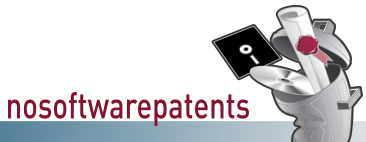| English | Deutsch |

![- Logo]](../images/layout007-small.png)
| Home |
| Software Patent of the year 2006 |
| About |
| Supporters |
| Background |
| News |
| Press November |
| Links |
| Contact |
| Imprint |
September – Patent 1
- EU-Patent on software (algorithm)
- Application to the European Patent Office on 28/9/1999 by Hitachi, Ltd. (Japan)
- Granted on 3/5/2006
- Date of priority: 29/9/1998 (valid no more than until 29/9/2018)
- Patent attorney: Mewburn Ellis LLP
- Patent specification provided by FFII/Gauss
- Patent specification provided by EPO/espacenet
- The decisive element are the claims, as they specify which actions are forbidden within the framework of the patent.
- Violating one single claim is sufficient to be considered a patent violation. Generally, claim number 1 is the decisive main claim which covers all other claims relating to special cases.
- The description is intended to help the reader interpret the claim. At the same time, it is supposed to document and disclose the details of the invention. This disclosure is the original purpose of the entire patent system.
- In practice, a patent specification contains no detailed information on how the patented procedure could be implemented (even if the patent owner allowed the implementation). In particular, a software patent contains no program code (reference implementation), but merely describes the idea of a software.
Patented idea: Evaluation of the manufacturing defects on the basis of the designs and defect statistics of the components and of the processing stages.
Main claim: Registering the defect statistics of the component and manufacturing features of a product, comparing them with the designs ("design information") and thus (in a modality that is not described in detail) computing and displaying (degree and type of the defects) the defective ratio of the product.
Further claims:
- During the computing of the defective ratio: computing for each part of the product and for the whole product.
- During the displaying of the defective ratio: displaying for each part of the product and for the whole product.
- Upon displaying the product, visual highlighting of the sections where there is a "chance" of defect.
- Different display according to the defective ratio.
- Displaying an object, the correction of which reduces the defective ratio. (The modality to determine this object remains open)
- Saving of defect information in a memory.
- Calling defect information from an external storage medium.
- Device (for ex. computer with software) which carries out the patented method.
Description: The patent specifications document the finding that the computing of the defective ratio of a product is not exact if performed only on the basis of the number of individual parts and of the processing stages and that it is better that the structure features of the product should be taken into account.
Everyday life parallel: A cook would like to present his latest dessert to 100 selected guests. The main ingredients ("components") are: a fresh, unsplashed apple as well as a strawberry with a certain form and size. The apprentice asks how many apples and strawberries to buy. The cook answers: "According to experience, every twentieth apple has a worm. As far as the strawberries are concerned, every other fifth strawberry has an improper form or size. The preparation goes wrong in one of ten cases."
The apprentice writes down these values "displaying the degree and type of defects"). On their basis, he computes – not in a modality described in detail – the probability that the dessert should not be good ("defective ratio of the product") and in the end buys as many ingredients so that the probability that the 100 desired desserts are good may be higher.
Examples for patent infringements:
- Software for insurances
- Many companies compute on the basis of the patented modality the defective ratio of their products – usually with commercial table calculation software.
| Previous Software Patents of the Month |
| > September |
| Patent 1 | |
| Patent 2 | |
| Patent 3 | |
| Patent 4 | |
| Patent 5 |
| > August |
| > July |
| > June |
| > May |
| > April |
| > March |
| Press Archive |
| > Oktober |
| > September |
| > August |
| > July |
| > June |
| > May |
| > April |
| > March |
